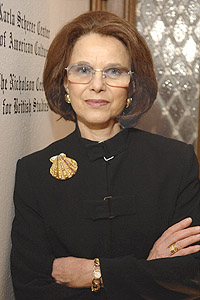From a cultural perspective, Karla Scherer develops idea for center
By Josh SchonwaldNews Office
 Karla Scherer | |
The idea for the Karla Scherer Center for the Study of American Culture was very much shaped by Scherer's vision and her own firsthand experience as a student at Chicago.
The daughter of Robert Scherer, the inventor of the machine that revolutionized the manufacture of soft, elastic gelatin capsules and the founder of the R.P. Scherer Corporation, a contract manufacturer of gelatin capsules, Scherer is perhaps best known as an advocate of shareholder's rights. In 1988, she led a shareholder proxy fight for control of the Scherer Corporation. The subsequent sale brought a price more than double the value of each shareholder's investment the previous year.
In 1989, she established the Karla Scherer Foundation, whose original purpose was to provide scholarship assistance for women pursuing degrees in economics and finance. But during the course of running the scholarship program, Scherer, who personally oversaw investments and interviewed and handpicked scholarship recipients, discovered that the strongest candidates were often women with a strong background in the humanities. Scherer, who attended Wellesley College and graduated from the University of Michigan in 1957, became increasingly interested in humanistic scholarship.
In 1998, with the encouragement from Carroll Joynes, Executive Director of the Cultural Policy Center at the University and a friend of Scherer's, she enrolled in Chicago's Master's Program in the Humanities. The experience was transformative. “People often tell me, 'I've never seen you happier than when you were at Chicago,' ” Scherer said.
In particular, one of the highlights of her Chicago experience was when she discovered, she said, an approach to American history from a cultural perspective. As an English literature major at Wellesley and Michigan, she had studied art without the benefit of a cultural perspective. But it was at Chicago, while researching her master's thesis, “How Artists Defined American Women: 1763 to 1912,”—under the tutelage of Judith Barter, Curator of American Art at the Art Institute of Chicago and then a Visiting Professor at Chicago—that Scherer was encouraged to take a broader view in addition to aesthetic analysis.
In writing about the art of painters, such as James Peale and John Singleton Copley, she explored the historical, political and cultural context of each painting. This multidisciplinary look at American culture was, for Scherer, a “brand new way of studying and learning.”
Two years ago, Scherer approached one of her former professors at Chicago, Danielle Allen, who was then Dean of the Division of the Humanities. Scherer and Allen brainstormed on how best Scherer could fulfill her specific interest in supporting the study of the United States from a cultural perspective across interdisciplinary boundaries at Chicago.
Allen conferred with faculty about Scherer's idea for a center focused on American culture and found great enthusiasm.
Throughout discussions with members of the University, Scherer emphasized that she wanted the center to be focused on the culture of the United States. “It's not for politically chauvinistic or jingoistic reasons,” Scherer said, “but simply, because there is such a rich abundance of material here.”
![[Chronicle]](/images/sidebar_header_oct06.gif)